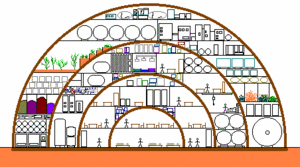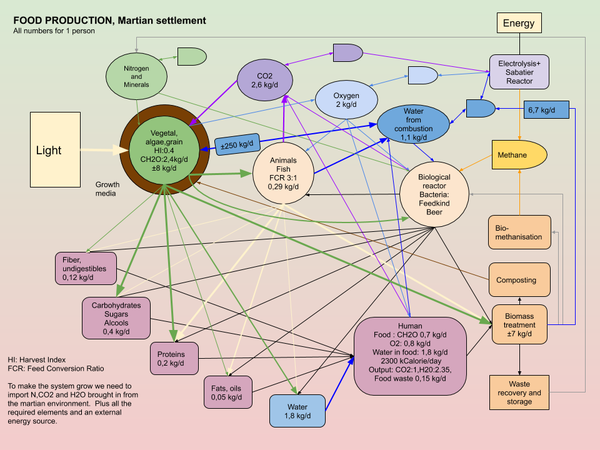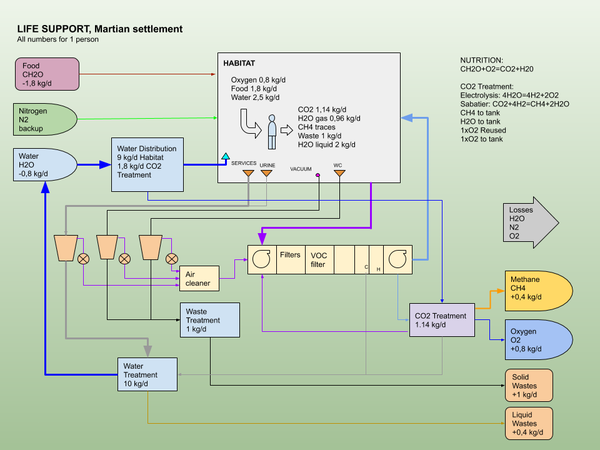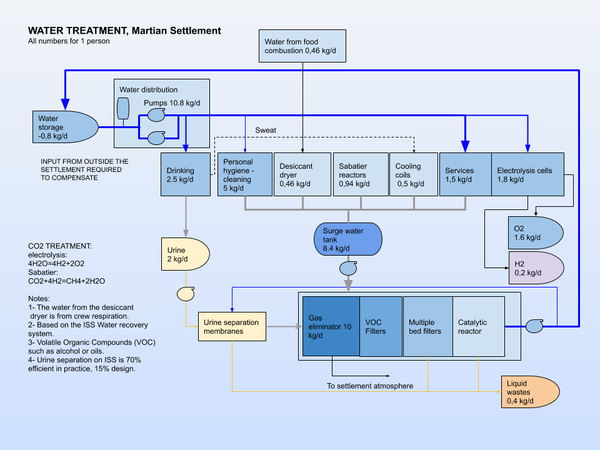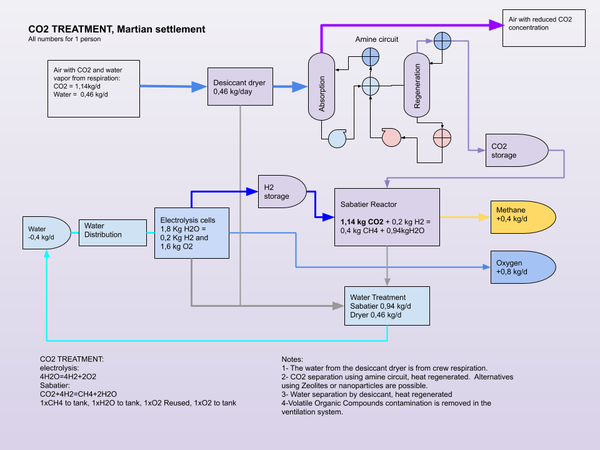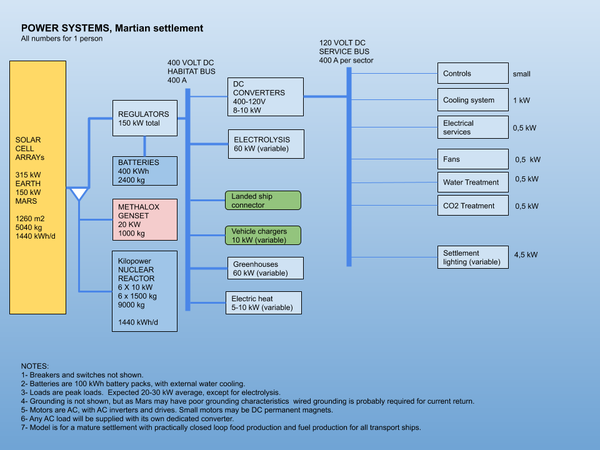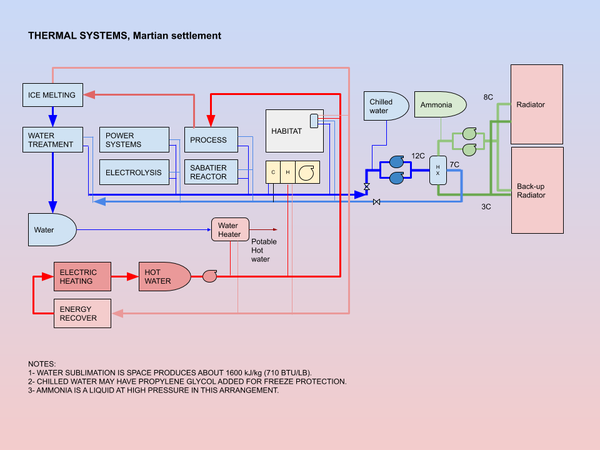Life support
Live support systems are an essential and necessary part of a Martian settlement, since the natural Martian environment does not allow human beings to survive. More information on this topic is included in How living on Mars will be different than living on Earth. Life support systems will be part of all the Mars settlement facilities and one of the main settlement systems. The maintenance of the life support systems will be a task that takes up a lot of the time of the settlers.
Contents
Requirements
- Water is the most important requirement. No water no life.
- Oxygen must be combined with nitrogen to create breathing air inside the habitat.
- CO2 must be removed, ideally by plants.
- Food must be provided.
- The temperature inside the habitat must be comfortable.
- Waste must be treated and recycled.
NASA table of inputs to support a person in space (1977)
| Input | Per day | Per year | 1000 people |
| Dry food | 0,6 kg | 219 kg | 219 tonnes |
| Sanitary water | 2,3 kg | 840 kg | 840 tonnes |
| Water | 1,8 kg | 657 kg | 657 tonnes |
| Oxygen | 0,9 kg | 329 kg | 329 tonnes |
| Total | 5,6 kg | 2 153 kg | 2 153 tonnes |
The numbers are slightly different from other references. So we should provide for a certain margin of safety!
Water consumption, water cycle
Average water requirements are about 3 l/day for men and 2,2 l/day for women. For drinking purposes only. The water is not chemically changed in the body (unlike oxygen, for example) and can be recycled indefinitely. The human body actually creates extra water by combining oxygen with the hydrogen in carbohydrates, plus a bit of methane. Respiration produces about 0,4 kg per day of water vapor, so 1000 people will produce about 400 kg of water vapor per day, that will need to be removed from the atmosphere.
Food requirements
Humans require on average 2000 calories for women and 2500 calories for men, or about 2.2 kg of food per day. Food calories are in fact Kilo-calories; metric equivalents are 8,4 MJ per day for women and 10 MJ per day for men. This can be converted to an average power of 97W for women and 115 Watts for men. So on average, a human uses as much power as a 100W light bulb.
Oxygen consumption, oxygen/CO2 cycle
Humans breath about 11 000 liters of air per day of which 21%, or 2310 l is oxygen. Since we breathe out air at about 15% oxygen, 25% of the oxygen is consumed, or about 550 liters of oxygen per day. The density of oxygen is 1,4 g/l, or 1,4 kg/m3. So each crew member 'uses' 0,7 kg of oxygen per day. The oxygen is mostly used to burn hydrocarbons in cells, producing both water and CO2. The combustion of carbon creates CO2 according to the following equation: C + O2 = CO2 + 395 KJ/mole, or 9000 kJ/kg. 1000 people will consume 700 kg of oxygen per day and produce about 1 ton per day of CO2. 1000 people will breathe 11 000 m3 per day.
CO2 concentrations
Carbon dioxide concentrations are normally 400 PPM, or 0,04% of the atmosphere. Large variations are possible, but the maximum comfort zone is between 600 and 1000 ppm. Adverse health effect appear at 2500-5000 ppm. At 50 000 ppm and more severe symptoms occur and eventually death.
This sets the limits for the CO2 amount in the settlement atmosphere. For a 1000 person settlement, settlers produce about 1 ton of CO2 per day. If there is no CO2 recycling, the concentration will go up fairly slowly. Allocating 100 m3 per settler, the volume would be 1 million m3 and hold about 400m3 of CO2, or 560kg. At one tonnes per day, it would take about one day to move up to 1200 ppm and about five days to reach the more dangerous levels of 5000+ ppm.
Nitrogen supply
Nitrogen is often seen as a relatively neutral buffer gas. However, there is a nitrogen cycle in a natural life support system required for plant life. Nitrogen is relatively rare on Mars, so nitrogen losses should be kept to a minimum. (However, some theorize that large nitrate deposits will exist on Mars, see Atmospheric loss.)
Artificial life support systems
An example of an artificial life support system, the life support system on the ISS is optimized to low weight. It must be fueled with large amounts of energy and it requires a constant replenishment with consumables.
The following example numbers are for a population of 1000 settlers and can be generalized to smaller populations. Artificial life support systems become impractical eventually, but are fine for spaceships and may be sufficient for the first years of a settlement.
Parts of the artificial life support systems can be used as back up to natural systems, or can serve as regulatory systems if natural systems go wrong.
Food
Average food requirements for 1000 people is about 2 tons per day, may be reduced to 1 ton per day or less with dehydrated foods. Stored food is practical for the first phases of a settlement but become impractical rapidly. There is presently no practical way to produce food entirely artificially. So food is an input to an artificial life support system, and these are necessarily open systems.
Potable water treatment
The system should be able to treat the water requirements for 1000 people. The theoretical minimum requirement is 3 l/day per person, or 3 m3 ( 3 tons) of fresh drinking water per day. Further allocations will be required for washing, sanitary usages, food production and other processes.
Sanitary waste treatment
The system should be able to treat/eliminate solid organic wastes, about 2 m3 per day for 1000 people. The system may be dry (compost) or wet (black water, i.e. sanitary piping and waste water treatment).
Grey water treatment
Water used for washing, showers and purposes other than human wastes must be recycled. This will be at least equal to the potable water requirements, but may eventually be significantly higher.
Atmospheric water
Water from sweat and respiration is also recycled, at a rate off about 1 kg per person. Water is removed from air by condensation or desiccation with regenerative media. Any plants in the habitat will add significantly to the atmospheric water load through evapotranspiration.
Air recycling
The air recycling system must be able to convert: 1 ton per day of CO2 into oxygen from human respiration, the CO2 (amount to be confirmed) from waste treatment. It must control humidity between 20 and 40%, limit temperature changes between 22 and 25 C and eliminate odors and volatile organic compounds. The air recycling system may also be used to transfer heat between different areas of the settlement. Water and refrigerant based heat transfer systems will be required to supplement the air recycling system.
If no air recycling is provided, the air replacement system must remove the CO2 and supply 770 kg of new oxygen per day, or a total of 280 tons of oxygen per year. A combined supply/recycle system may be acceptable for a very early settlement but needs to become autonomous rapidly.
Air, water and other resources losses
The life support system must be designed to handle air and water losses. The system should be able to replace a certain percentage of losses, and take into account some degradation and contamination that makes recycling of some materials uneconomical.
Near-natural life support systems
On Mars an artificial life support system can provide all the needs of the occupants except for food. And in the long term importing all food from Earth is not practical. To produce food locally, a near-natural carbon cycle with the growing of food and the production of oxygen at the same time is required.
The challenge is the day and night rhythm as well as the lasting dust storms. Food can only produced with light, either sunlight or artificial light. During the night or during a dust storm there may not be enough sunlight, either for direct lighting for the plants or for photovoltaic powered electric lights. The Biosphere 2 experiment has shown significant deviations from good oxygen conditions due to the day and night rhythm. So even with a natural life support system there may be requirements for artificial back-up or support.
The first Martian settlement will probably be much smaller than Biosphere 2, making it even harder to keep a constant oxygen level. There are solutions to mitigate this issue by using artificial life support systems.. The larger the settlement, the more stable it will be, as it will have more inertia, and the less artificial life support will be required.
Food production from plants
Food production is the greatest benefits of a natural life support system. It closes the loop on carbon usage by recycling the carbohydrates into the cycle of the life support system.
Food production systems are fairly massive. Studies done for the O'Neill colonies in the seventies proposed that the mass of a biological food production system with recycling was about seven times the mass of the food itself (ref needed). Mars might have advantages on space colonies as the in-situ resources would reduce the mass that needs to be brought from Earth and make a food production system economical much earlier. The greenhouse area required for the food production of one person is about 365 m2, so about 10 times the living area's surface.
Food production from biological reactors
Food can be produced from biological reactors, bypassing the need for plants. These technologies are in their infancy.
Buffering the gases
Humans breathe oxygen, but an atmosphere of pure oxygen at 1 bar pressure would be toxic and explosively flammable. We require buffer gases to reduce the partial pressure of oxygen. On Earth the primary buffer gas is nitrogen. The Martian atmosphere contains the noble gases neon and argon which also can be used as buffer gases.
Large tanks of water may be used to buffer some amount of oxygen as well as CO2, since those gases are soluble in water according to Henry's law. A good side effect is the heat capacity of the water, helping to keep a comfortable temperature in the settlement. Oxygen produced for propellant purposes will need to be stored, and this storage can be used to buffer some of the oxygen. CO2 can be extracted from the atmosphere and the carbon stored in methane as CH4. Artificial life support systems can be used in parallel to help regulate the overall system.
Plant life produces excess oxygen for a life support system that only includes humans. The Mars One life support system design was criticized for producing too much oxygen, leading eventually to oxygen poisoning of the colonists[1]. It will be possible to remove excess oxygen using separation methods, but this reduces the possibility of an entirely 'natural' life support system, at least in the early years of the settlement.
An atmosphere like Earth's will require a lot of nitrogen. One with of 0.2 bar of oxygen, and 0.2 bar of nitrogen, (plus a trace of neon & argon), might be a reasonable compromise for plant health, safety, and expense. However the nitrogen cycle of plants might be affected, so further study is needed.
Energy storage
Some of the oxygen producing greenhouses may be lit at night, which requires stored electrical energy or Nuclear power sources. However, it would probably be better to follow Mars' day and night cycle and reduce energy storage requirements. The stored energy quantity must be large enough to cover a few months of dust storms, again, unless nuclear reactors are used. wind turbines may help to produce part of the needed energy during storms, but burning extra stored propellant may be more efficient. Food production and industrial production will also be reduced during sandstorms and any leftover solar power used for the habitats.
Water
Water can be extracted from the atmosphere of from frozen deposits on the surface. Once it enters the life support system, water becomes part of the life process and ends up either in food, at the water treatment plant mixed up with waste, or in the atmosphere as a result of respiration. Water is also the source of propellant, so large amounts of water are required for the settlement. Water has very high specific heat, therefore it can hold a lot of heat. Water storage of energy is a good source of stability and inertia in a settlement life support system.
Respiration from humans and evapotranspiration from plants will load the atmosphere of a settlement with humidity. This water needs to be removed by condensation, or the humidity will become too high and the plants will no longer function, and the humans will be very uncomfortable. Desiccant systems with regeneration or cooling systems with condensation are two methods for dehumidifying the air in the settlement. The cold outside the colony can be used at a handy heat sink for dehumidification as well.
Plants require large amounts of water to function correctly. In greenhouses, water irrigation requirements have a typical value of 10 to 16 l/m2 per day[2]. So plants to feed one person require up to 16 l/m2 x 365 m2/person = 5 840 liters per day. This water must be recycled and is more than 1000 times the water required for direct human consumption.
Energy requirements
Energy is required to run the life support system. The source of the energy is either the sun, though direct radiation of photoelectric systems, or nuclear fuel, using nuclear reactors, or a sum of both. The energy required to run the life support system when food production is included is considerably more (5 to 10 times more) than the energy required to produce propellant or to support industry.
The larger the life support system, the more stable it is. Humans operate at about 100W of power. This comes from food, that eventually comes from photosynthesis. Photosynthesis has an efficiency of about 3-4%, but most of the production from photosynthesis is used by the plant itself. About 0,5 to 1% of the energy from photosynthesis turns into food for humans. So the life support system of a settlement that includes food production will require a minimum of 100W/1% = 10 000W to 20 000W of average power per inhabitant. The other 99% of the energy absorbed by plants is turned into plant structure, and eventually biomass (about 1-2%) and heat (97-98%). The heat is mostly in the form of evaporated water, known at latent heat, and a hot air, called sensible heat. This heat needs to be removed from the settlement to avoid overheating.
The heat loss rate of the settlement habitat depends on its construction. If it is well insulated, it will lose little heat, and will need to be cooled using active mechanical systems. If it is poorly insulated it could cool itself by radiation and convection to the Martian environment. However, if the heating ever failed the settlement might freeze rapidly.
As it is easier to stop food production in case of a loss of power, in fact, it pretty much stops itself, it makes more sense to insulate the settlement that to try to have it in thermal equilibrium.
As the water in the Martian environment is mostly frozen, thawing it into liquid water for settlement use and propellant production is a great heat sink for the settlement excess heat. The power required for life support is often estimated at about 60 kW per person (Kalpana) and (Mars one).
See also
References
NASA. Life Support Baseline Values and Assumptions Document. Probably the best source of information today (2020)
- ↑ Do, Sydney, Koki Ho, Samuel Steven Schreiner, Andrew Charles Owens, and Olivier L. de Weck. "An independent assessment of the technical feasibility of the mars one mission plan." (2014).
- ↑ https://ag.umass.edu/greenhouse-floriculture/fact-sheets/sizing-greenhouse-water-system
